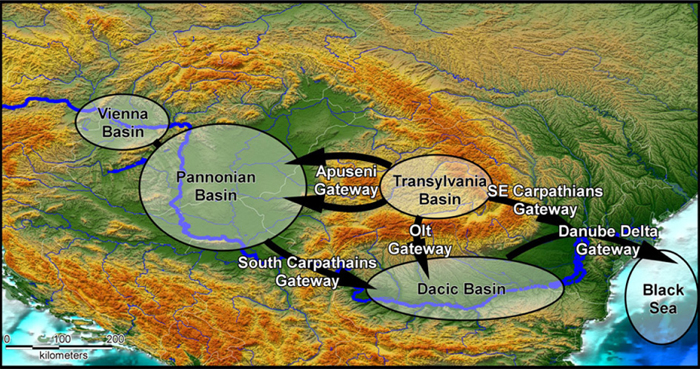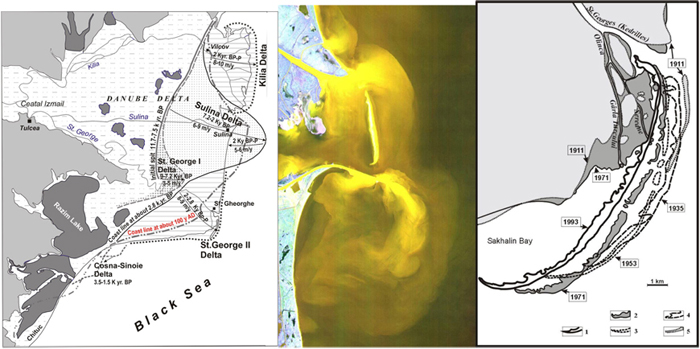| © 2008 by SourceSink consortium - all rights reserved |
Problem statement: The goal of the project is to investigate the factors which governed the geomorphologic and geo-environmental evolution during the last 5Ma of the Lower Danube –Danube Delta – Black Sea carrier system. The project will focus on the lower Danube River and on the sedimentary gateway at the interface between the Dacic Basin and the Black Sea, i.e. the modern Danube Delta.
Aims and objectives: The study aims a comparative analysis between the deltaic filling patterns observed during the Pliocene in the SE Carpathians foreland and the modern sedimentological processes (Upper Holocene towards the last 30 years) observed in the Danube and Danube Delta at the interface with the Black Sea. This general objective will be obtained by the means of data acquisition, interpretation and modeling focused around 5 topics.

The Carpathians – Pannonian - Dinarides system and its basins – orogen – gateways relationships. The study area is located in the Dacic basin, the Danube Delta gateway and the interface with the Black Sea.
1. The remote past (5 to 1 million years):
- Provenance and sediment distribution within the Dacic Basin: we aim to quantify rates of sediment infill and the geometry of Pliocene deltaic bodies. This objective will benefit from extended available expertise both in outcrops and depth studies of IP05 and IP07. Of particular interest is the evolution of the South Carpathians gateway (Figure 2), a past analogue of the modern Danube Delta. This is a common objective with IP02 VU Amsterdam;
- Sediments interplay between the Dacic Basin and the Black Sea: we aim to quantify the distribution of Pliocene deltas (if any) towards the modern Danube Delta.
2. Near past (Quaternary):
- Deltaic sediments (carrier/sink interface) migration in space and time over the Danube Delta Gateway: the key is analysing the present-day architecture of the transition zone between the Dacic and the Danube Delta and its sedimentary budget;
- A direct extrapolation from the previous objective is the projection of the deltaic development impact on the evolution of the early history human settlements.
3. The Modern time:
- Danube Delta present-day evolution; quantification of the sedimentary budget: the objective will analyse the impact of present-day strain distribution derived from the on-going inversion of the Carpathians system over the development of deltaic architecture;
- Quantitative evolution of the sub-aerial Danube Delta by means of river high-resolution seismic acquisition. In combination with IP07 Uni Bucharest, the acquisition will reveal the geometry and evolution in time of the main deltaic components.
4. Near future of the Danube Delta:
- Sedimentological and wav-form modelling of key depositional parameters will allow a short- and long-term forecast on the Danube Delta evolution, in particular the frontal migration of sand bars (Figure 3). This will subsequently produce a forecast on the impact of the future changes on the Danube Delta human settlements.
Innovation: The presently proposed Danube Delta project offers innovative aspects through:
- Deriving the evolution through time of basin fill and deltaic architecture, in particular overstepping uplifted area crossed by gateways;
- Underlying the active sedimentological/tectonic patterns leading to the European Carrier;
- Study and quantification of the sedimentary exchange between Dacic Basin and the Black Sea during the Messinian to Modern times and linking the Messinian crisis with its effects in sedimentary depocenters shifts, incision and creation of gateways.
- Surveying the impact of the Danube Delta changes on the human communities development during the early history and in the foreseeable future.

The Danube Delta evolution during the Holocene and changes in coastline position (Panin and Ion, 1997); (middle) Sediment discharge into the Black Sea from the Sulina and Chilia deltaic channels; (right) Evolution of the modern St. George delta and Sahalin barrier island (Giosan et al., 1997)
Added value: Using surface and subsurface (boreholes) sedimentological methods the project will provide data about paleocurrent systems, sediment thickness/facies distribution, paleoenvironments and deltaic architecture in the SE Carpathians foreland during the Messinian - Holocene times. These data will be linked with results from other research domains which will investigate the provenance of the Danube system sediments through isotope thermocronology (IP01), high resolution surface analysis and faunal ecophysiology. The investigators of the dispersal systems in the Carpathic-Danubian space will also benefit of the present project results.
The present proposed project will also investigate the history of the human settlements in the Danube Delta area during the early historical time, supplying data of the societal relevance of the processes governing the topographic evolution at the carrier-sink interface.
Methodologies/experiments:
- Sedimentogenetic, paleontologic and high-resolution depth data acquisition and analysis of the Messinian - Pliocene deposits in the Dacic Basin for the provenance, dispersion and accumulation of the sediments in the Carpathian-Danubian space and their transfer towards the Black Sea.
- The aerial photography mapping and sedimentogenetic, paleobiologic and mineralogic study of the Quaternary deposits in the Danube Delta area in order to reconstruct the sedimentary architecture at the carrier/sink interface and to evaluate the sedimentary budget
- The very high resolution seismic survey of the deltaic and prodeltaic area to point out the architectural and sedimentary relationships between the Danube Delta and the Black Sea shelf during the Holocene.
- The sedimentologic and hydrologic study/documentation to evidence the modern evolution of the Danube Delta in relationship with the Black Sea and the effects of the human intervention on the carrier-sink system.
- The work out the acquired data in order to build up a conceptual model of the near future evolution of the Danube Delta topography under natural and man-made intervention; impact on the human settlements in the Danube Delta.
Deliverables and/or milestones:
Distant past (Late Neogene) Dacic Basin/Lower Danube River system:
- Dynamic topography prior to appearance of the Lower Danube;
- Dacic Basin/Lower Danube R. - Black Sea sedimentary pathways;
- Lower Danube River occurrence; processes and interaction;
Near past (Quaternary):
- Danube Delta as a pathway to the Black Sea. Sedimentary architecture and the carrier/sink interface evolution;
- Sedimentary budget at the carrier-sink interface;
Present-day Danube-Black Sea system
- Trends of the sediment transport, deposition/erosion processes;
- Man-made intervention;
Near future of the Danube Delta
- Conceptual model of the Danube Delta near future evolution.
|